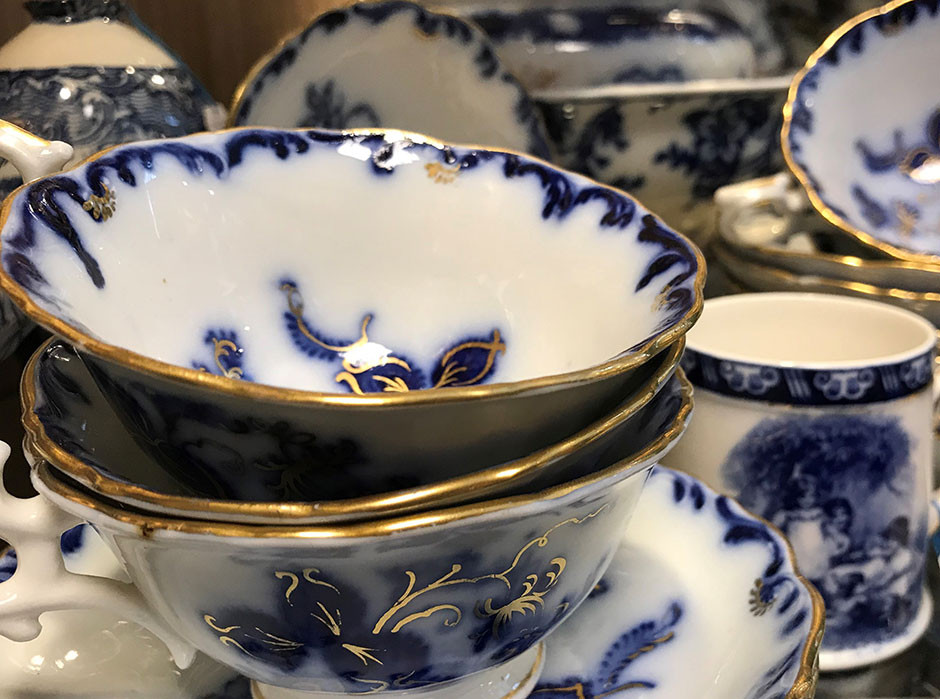
There's been a continued nervousness that the antique porcelain market is 'soft', but that couldn’t be further from the truth. Porcelain antiques, despite being prone to breakages, are the most naturally durable wares and are highly collectable. Thanks to the immense volume of decorative wares, from antique porcelain jugs and vases to bowls and antique porcelain plates, it’s a vast and rewarding market for dealers to explore. From cleaning tips to spotting a ceramic ‘sleeper’ (an unidentified treasure), here's how dealers can stay in-demand in the world of antique porcelain, starting from the very beginning...
1.Learn how to identify antique Chinese porcelain
Some of the earliest and most valuable antique porcelain hails from China (browse some of our Oriental porcelain here). The first glazes were used at the end of the 2nd millennium BC and ceramics became ever more refined from the 3rd century onwards. First thing’s first when it comes to being a ceramics pro - here’s how to identify antique Chinese porcelain from different dynasties:
- Shu fu antique porcelain. Antique porcelain developed to its full potential in the city of Jingdezhen, when Shu fu wares were produced. These can be identified by thickly potted porcelain, a waxy, greyish-white opaque glaze and the Chinese characters shu and fu moulded onto ceramics.
- Doucai wares. A fine white antique porcelain, with underglaze-blue outlines and overglaze enamels in red, green, yellow and aubergine. Usually small, neat porcelain antiques such as wine cups, jars and bowls. Check for chickens, peonies, dragons, plants and floral designs.
- Wucai wares. White antique porcelain which varies in quality - similar to Doucai glazes with some outlines in red and black. These are more likely to be larger pieces such as massive cisterns covered in dragons, fish, figures and landscapes.
- Export wares. The loss of imperial patronage at Jingdezhen in 1608 spurred Chinese potters to explore new markets. Export porcelain antiques had European influences, tending to be thin and light, of decent quality and with the glaze often breaking away from the edges in an unusual fashion. Look for high gloss, wishy-washy blues and gritty glazes. Antique porcelain plates, jars and flasks are often decorated with panels separating animals, flowers, plants or landscapes.
1644-1911: Antique porcelain from the Qing dynasty
Blue and white porcelain antiques dominated the market during the Qing reign periods. If you’re looking at how to identify antique Chinese porcelain from this time, pieces should be extremely neat and delicate, made from very fine white porcelain. While the footrims of Ming ware curves slightly outwards, Qing is smooth and rounded. Look for painterly decorations of blossoming branches often filled with fruit and good luck symbols such as the characters shou (long life) and fu (bat).
2. Specialise in specific antique porcelain wares
When porcelain arrived in Europe in the early 1500s, it took off everywhere from Germany to Britain. Becoming a specialist in one particular type of antique porcelain can set you ahead of the market and make your wares irresistible to collectors. Here are a few types of porcelain antiques from different periods and makers to get you started:
- Any work by German enamelling master Johann Gregorius Höroldt is snapped up at auction, especially his early chinoiserie scenes. A typical Baroque-style beaker and saucer slathered in gilt borders and embellished in iron red and puce from around 1723 can value at around £4,000 to £6000.
- Look out for stunning Meissen antique porcelain. Johann Joachim Kändler was the most important modeller at the German factory during this period. His antique porcelain ranges from glorious bird figures (Roller from 1740 values between £10,000 to £15,000) to unusual, colourful characters (Harlequin Alarmed from 1738 has a value of up to £40,000). Later pieces by modellers such as Christian Gottlieb Juchtzer can reach up to £4,000 (Cupid Unchained, 1870-80).
- You can’t go wrong dealing Royal Worcester antiques. Scour auctions and markets for everything from antique Worcester plates, teawares and sauce boats to vases, pickle dishes and potting pans. The latter (tubs for serving potted meat) were a key part of the Worcester factory’s output. A quality antique Royal Worcester potting pan from 1754, in the factory’s trademark brand of chinoiserie decoration, can value up to £15,000.
3. Know how to spot fake antique porcelain
Exquisite porcelain of the East was regularly faked by European potters, for big profits. The irony is that these “fakes” are now worth far more than the originals they copied. However, more recent forgeries can be difficult to detect.
It’s important to clue-up on signs of authenticity, such as checking the body and glaze to make sure they’re correct for the age and style of the antique porcelain. Fakers often overdo signs of antiquity. If the condition for a 300-year-old set of antique porcelain plates is too good to be true, compare it to genuine pieces and question whether the colours seem right.
Certain shades were not used in the 18th century, bright blues especially. If the piece is dirty, is the grime in genuine hard-to-clean areas? Is rubbing or wear naturally or could it have been done with sandpaper? Have a browse through our top quality collection of genuine antique porcelain to see the real deal.
4. Clean and care for your antique porcelain
If you’ve ever scoured antique porcelain at an auction, market or shop, you’ll have seen just how common it is to find absolutely filthy porcelain antiques. But a good wash with nothing more than a bit of liquid detergent can do wonders for your wares. Use a soft cloth to clean antique porcelain, or a soft toothbrush for awkward-to-clean pieces like antique porcelain jugs. Avoid rubbing gilding as this can come away easily and reduce the value of your antique porcelain and never immerse hollow figurines in water.